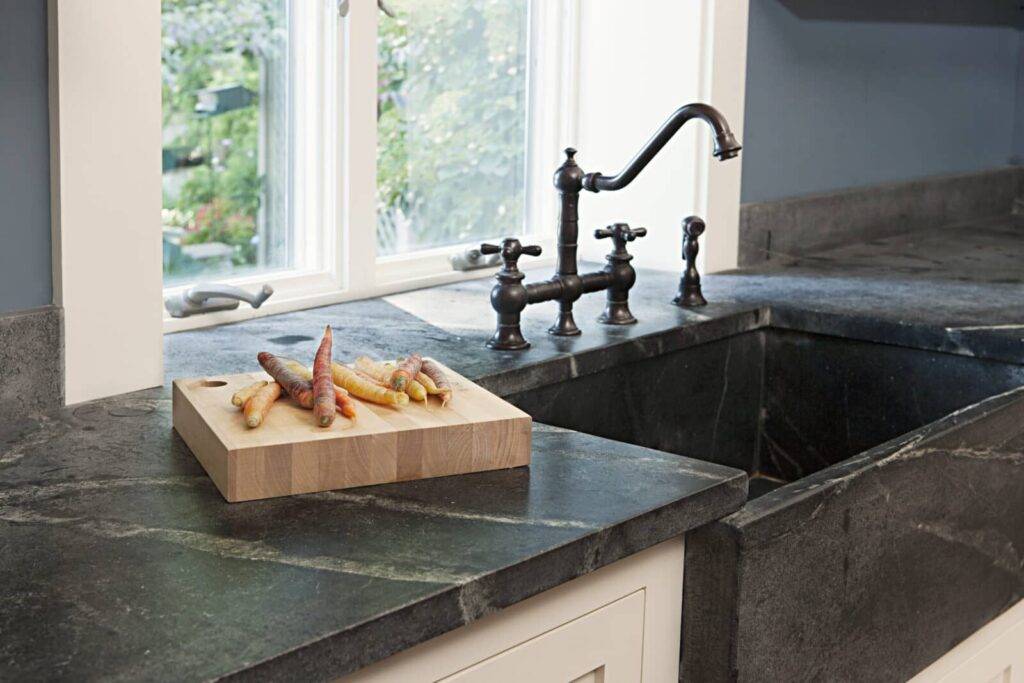Soapstone Countertops Simplified: All Your Main Questions Answered
Soapstone is a natural stone, much cherished in the world of kitchen and bathroom décor for its distinct qualities and aesthetic flexibility. If you’re considering natural stone countertops, you’ll find soapstone to be a unique and functional option for your kitchen or bathroom countertops, as well as fireplace surroundings. By understanding what soapstone is, its types and colors, as well as its advantages and drawbacks, you will be able to make an informed decision about this material.
What is Soapstone?
Soapstone is a metamorphic rock, known for its soft feel and dense composition. It contains talc, chlorite, dolomite, and magnetite, which give it a soft, soapy texture on the surface. It’s mainly found in shades of gray, blue, or green, and its non-porous nature makes it resistant to stains and bacteria. This makes it an excellent choice for countertops where you want beauty, hygiene and durability.
Types and Colors of Soapstone
Soapstone varies greatly in type and color, depending on the region it’s quarried from and the specific mineral composition. The most common colors of soapstone are various shades of gray with veins of white or quartz, though some stones may also appear green or bluish. Its natural veining pattern is often less pronounced than in marbles, providing a subtle, uniform appearance that suits a variety of décor styles from rustic to modern.
The two primary types of soapstone are artistic and architectural grades. Artistic soapstone has a higher talc content, making it softer and more suitable for carving but less ideal for countertops due to its susceptibility to scratching. Architectural grade soapstone, on the other hand, has less talc, which provides the durability needed for heavy-duty kitchen use.
Pros and Cons of Soapstone Countertops
Pros:
- Durability: Despite its softer nature, soapstone is remarkably durable. It is non-porous, making it resistant to stains and bacteria—an essential feature for kitchen surfaces.
- Heat Resistance: Soapstone can withstand high temperatures without damage. Hot pots can be placed directly on the surface without any risk of scorching or cracking the stone.
- Low Maintenance: Unlike other natural stones that require sealing, soapstone’s non-porous nature means it requires very little maintenance. Occasional application of mineral oil can help to even out the color and enhance its natural beauty.
- Aesthetic Appeal: With its rich, deep colors and subtle veining, soapstone brings a unique beauty to any space. It ages gracefully, developing a sought-after patina that can enhance its character over time.
Cons:
- Scratch Visibility: Soapstone is relatively soft, which means it can be prone to scratching. However, these scratches can often be sanded out or camouflaged with mineral oil.
- Limited Color Range: If you are looking for bright or high-contrast colors in a countertop, soapstone may not meet your needs as it primarily comes in darker, more muted tones.
- Cost: Soapstone is generally more expensive than some other countertop options, which could be a consideration for those on a strict budget.
Cost of Soapstone Countertops
The cost of soapstone countertops can vary widely depending on the thickness of the slab, the complexity of the installation, and the geographic location. Generally, prices range from $70 to $120 per square foot installed. Factors that contribute to the higher cost include the rarity of the material, the quarrying process, and the craftsmanship required for installation. The investment in soapstone is often justified by its longevity and the value it adds to the home.
Frequently Asked Questions (FAQ)
- How should I clean and maintain my soapstone countertops?
- Simply wipe them down with a damp cloth and mild soap. There’s no need for special cleaners or sealants, which keeps upkeep easy and straightforward.
- Can soapstone countertops be repaired if they get damaged?
- Yes, if your soapstone gets scratched, you can usually sand out the scratches yourself or fill deeper ones with a mix of mineral oil and stone dust.
- How does the aging process affect soapstone?
- Over time, soapstone darkens and develops a richer patina. Many people find this adds to the countertop’s character, and you can use mineral oil to help achieve an even patina.
- Is soapstone suitable for outdoor kitchens?
- Absolutely, its density and resistance to temperature changes make soapstone an excellent choice for outdoor settings.
I hope this detailed overview helps you understand the unique benefits and considerations of soapstone countertops. Whether it’s the aesthetic appeal or the functional benefits, soapstone offers a timeless yet practical solution for traditional to modern homes.

